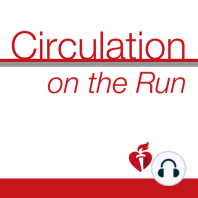18 min listen
Circulation November 8, 2022 Issue
ratings:
Length:
22 minutes
Released:
Nov 7, 2022
Format:
Podcast episode
Description
Dr. Carolyn Lam: Welcome to Circulation on the Run, your weekly podcast summary and backstage pass to the Journal and its editors. We're your cohosts. I'm Dr. Carolyn Lam, Associate Editor from the National Heart Center, and Duke National University of Singapore. And... Dr. Peder Myhre: I'm Dr. Peder Myhre from Akershus University Hospital, and University of Oslo in Norway. Dr. Carolyn Lam: Peder, I'm so excited about our future discussion. It's about a very important topic of detecting atrial fibrillation in the population using wearable devices. It talks about the Fitbit Heart Study. So exciting, but we're going to keep the audience waiting a bit, because we're going to talk about some other things in the issue. And I would love to start with this now. We know that fulminant myocarditis presentation is a rare and severe presentation of myocarditis. But, what is its natural history, and clinical features associated with poor outcomes? Peder, what do you think? Dr. Peder Myhre: Oh, that's a great question. We really don't know, because prior studies have been relatively small and selected. So Carolyn, let me know. Dr. Carolyn Lam: You're absolutely right. But today's paper from Professor Saito, from Nara Medical University in Japan and colleagues, is the largest nationwide cohort study of patients with histologically proven fulminant myocarditis presentation. They study 344 patients, hospitalized with histologically proven myocarditis, who underwent catecholamine and/or mechanical support from 235 cardiovascular training hospitals across Japan, between 2012 and 2017, and here's what they found. Over a median follow up of 600 days, the accumulative risk of death or heart transplantation at 90 days was 29%. So, really high. These were the risk factors associated with a higher risk of death or heart transplantation, and they were non-sinus rhythm, older age, ventricular tachyarrhythmia, lower left ventricular ejection fraction. Severe histological damage was also associated with a worse 90 day outcome in lymphocytic myocarditis. Cool, huh? Dr. Peder Myhre: Oh wow. That was some really solid data. And now Carolyn, I'm going to take us over to the world of preclinical science. And the next paper entitled at “APIC Associated De Novo Purine Synthesis is Critically Involved in Proliferative Arterial Disease” by Yuqing Huo from Augusta University in Georgia. Dr. Carolyn Lam: Cool. Dr. Peder Myhre: And as you know, Carolyn, vascular smooth muscle cells are extremely important in vascular health. They're located in the medial layers of arteries, and normally exhibit a contractile phenotype that contributes to the regulation of blood vessel tone, blood flow distribution, and blood pressure in normal mature blood vessels. And in response to disease processes, the vascular smooth muscle cells are switched to an activated synthetic and proliferative phenotype, that contribute to the development of a variety of arterial diseases, including atherosclerosis, in-stent restenosis, and bypass graft occlusion. And nucleotides that we are familiar with, such as ATP and GTP, are essential for a large number of biological processes in cells, including proliferation. And Carolyn, the previous studies have demonstrated that de novo synthesis of purine is a critical pathway for nucleotide synthesis. And in this study, the authors assessed the role of de novo synthesis of purine in vascular smooth muscle cells by using knockout mice. Dr. Carolyn Lam: Oh, that was beautifully explained. Thanks, Peder. So what did they find? Dr. Peder Myhre: So the authors found that the de novo purine synthesis was increased in proliferative vascular smooth muscle cells. Moreover, they identified an important enzyme in the process called A-P-I-C, APIC. Which was observed in the neointima of the injured vessels, and atherosclerotic lesions in both mice and humans. Finally, they showed that in a mouse model with knocked out APIC, the atherosclerosis and arterial restenosis w
Released:
Nov 7, 2022
Format:
Podcast episode
Titles in the series (100)
Circulation January 23, 2018 Issue by Circulation on the Run
